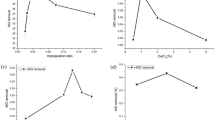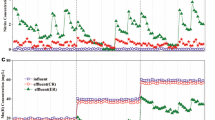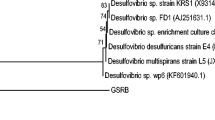Abstract
Single denitrification using bacteria has been widely investigated, but few studies have focused on the simultaneous removal of nitrate, phosphorus. and tetracycline. Strain L2, an iron-reducing bacteria, was immobilized using chitosan/polyvinyl alcohol to simultaneously remove nitrate and phosphorus. The effects of carbon/nitrogen ratio (1:1, 1.5:1, and 2:1), initial Fe2+ concentration (0, 15, and 30 mg·L−1), and HRT (2, 4, and 6 h) were assessed in bioreactors and optimum conditions were established. Results showed that the nitrate and phosphorus removal efficiency reached 100.00% (2.697 mg·L–1·h–1) and 81.93% (1.533 mg·L–1·h–1) under the conditions of carbon/nitrogen of 2:1, Fe2+ concentration of 30 mg·L−1 and HRT of 6 h. The precipitation of bioreactor, which identified as FeOOH by XRD, had significant adsorption on tetracycline. The results of high-throughput sequencing indicated that strain L2 played a significant role in denitrification. This bioreactor provided effective method for the treatment of polluted water contaminated by nitrate, phosphorus, and tetracycline.
Graphic abstract







Similar content being viewed by others
References
Horppila J (2019) Sediment nutrients, ecological status and restoration of lakes. Water Res 160:206–208
Jäger CG, Hagemann J, Borchardt D (2017) Can nutrient pathways and biotic interactions control eutrophication in riverine ecosystems? Evidence from a model driven mesocosm experiment. Water Res 115:162–171
Wang W, Wei D, Li F et al (2019) Sulfur-siderite autotrophic denitrification system for simultaneous nitrate and phosphate removal: From feasibility to pilot experiments. Water Res 160:52–59
Su JF, Liang DH, Huang TL et al (2017) Enhancement of simultaneous algicidal and denitrification of immobilized Acinetobacter sp. J25 with magnetic Fe3O4 nanoparticles. Environ Sci Pollut Res Int 24(21):17853–17860
Chauhan R, Srivastava VC (2019) Electrochemical denitrification of highly contaminated actual nitrate wastewater by Ti/RuO2 anode and iron cathode. Chem Eng J 122065
Du X, Zhang K, Xie B et al (2019) Peroxymonosulfate-assisted electro-oxidation/coagulation coupled with ceramic membrane for manganese and phosphorus removal in surface water. Chem Eng J 365:334–343
Wang Z, He S, Huang J et al (2018) Comparison of heterotrophic and autotrophic denitrification processes for nitrate removal from phosphorus-limited surface water. Environ Pollut 238:562–572
Meinikmann K, Hupfer M, Lewandowski J (2015) Phosphorus in groundwater discharge – A potential source for lake eutrophication. J Hydrol 524:214–226
Wang Z, Jiang Y, Awasthi MK et al (2018) Nitrate removal by combined heterotrophic and autotrophic denitrification processes: Impact of coexistent ions. Bioresour Technol 250:838–845
Zhang H, Feng J, Chen S et al (2019) Geographical Patterns of nirS Gene Abundance and nirS-Type Denitrifying Bacterial Community Associated with Activated Sludge from Different Wastewater Treatment Plants. Microb Ecol 77(2):304–316
Huang X, Dong W, Wang H et al (2019) Experimental Study on Deep Chemical Phosphorus Removal Based on High Discharge Standard. IOP Conf Ser 237:22034
Ifelebuegu AO, Ojo P (2019) Modelling the effects of ferric salt dosing for chemical phosphorus removal on the settleability of activated sludge. J Environ Chem Eng 7(5):103256
Zhang X, Lin X, He Y et al (2019) Phenolic hydroxyl derived copper alginate microspheres as superior adsorbent for effective adsorption of tetracycline. Int J Biol Macromol 136:445–459
Zhang P, Li Y, Cao Y et al (2019) Characteristics of tetracycline adsorption by cow manure biochar prepared at different pyrolysis temperatures. Bioresour Technol 285:121348
Fu Y, Peng L, Zeng Q et al (2015) High efficient removal of tetracycline from solution by degradation and flocculation with nanoscale zerovalent iron. Chem Eng J 270:631–640
Choi K-J, Son H-J, Kim S-H (2007) Ionic treatment for removal of sulfonamide and tetracycline classes of antibiotic. Sci Total Environ 387(1–3):247–256
Salari M, Rakhshandehroo GR, Nikoo MR (2018) Degradation of ciprofloxacin antibiotic by Homogeneous Fenton oxidation: Hybrid AHP-PROMETHEE method, optimization, biodegradability improvement and identification of oxidized by-products. Chemosphere 206:157–167
Ma Z, Hu L, Li X et al (2019) A novel nano-sized MoS2 decorated Bi2O3 heterojunction with enhanced photocatalytic performance for methylene blue and tetracycline degradation. Ceram Int 45(13):15824–15833
Hopkins ZR, Blaney L (2014) A novel approach to modeling the reaction kinetics of tetracycline antibiotics with aqueous ozone. Sci Total Environ 468–469:337–344
Fu M, Xing J, Ge Z (2019) Preparation of laccase-loaded magnetic nanoflowers and their recycling for efficient degradation of bisphenol A. Sci Total Environ 651(Pt 2):2857–2865
Xue J, Wu Y, Shi K et al (2019) Study on the degradation performance and kinetics of immobilized cells in straw-alginate beads in marine environment. Bioresour Technol 280:88–94
Su J, Bai Y, Huang T et al (2019) Performance and Microbial Community of Simultaneous Denitrification and Biomineralization in Bioreactors. Chem Eng Technol 42(3):637–644
Preto MF, Campana-Filho SP, Fiamingo A et al (2017) Gladius and its derivatives as potential biosorbents for marine diesel oil. Environ Sci Pollut Res Int 24(29):22932–22939
Dellagnezze BM, Vasconcellos SP, Angelim AL et al (2016) Bioaugmentation strategy employing a microbial consortium immobilized in chitosan beads for oil degradation in mesocosm scale. Mar Pollut Bull 107(1):107–117
Muangchinda C, Chamcheun C, Sawatsing R et al (2018) Diesel oil removal by Serratia sp. W4–01 immobilized in chitosan-activated carbon beads. Environ Sci Pollut Res Int 25(27):26927–26938
Zou S, Yao S, Ni J (2014) High-efficient nitrogen removal by coupling enriched autotrophic-nitrification and aerobic-denitrification consortiums at cold temperature. Bioresour Technol 161:288–296
Xu C, Wang X, An Y et al (2018) Potential electron donor for nanoiron supported hydrogenotrophic denitrification: H2 gas, Fe0, ferrous oxides, Fe2+(aq), or Fe2+(ad)? Chemosphere 202:644–650
Li Z, Zhang Q, Jiang Q et al (2019) The enhancement of iron fuel cell on bio-cathode denitrification and its mechanism as well as the microbial community analysis of bio-cathode. Bioresour Technol 274:1–8
He Q, Song J, Zhang W et al (2020) Enhanced simultaneous nitrification, denitrification and phosphorus removal through mixed carbon source by aerobic granular sludge. J Hazard Mater 382:121043
Kiskira K, Papirio S, van Hullebusch ED et al (2017) Fe(II)-mediated autotrophic denitrification: A new bioprocess for iron bioprecipitation/biorecovery and simultaneous treatment of nitrate-containing wastewaters. Int Biodeter Biodegrad 119:631–648
Sun Y, Li J, Huang T et al (2016) The influences of iron characteristics, operating conditions and solution chemistry on contaminants removal by zero-valent iron: A review. Water Res 100:277–295
Wang B, Tian K, Xiong X et al (2019) Treatment of overhaul wastewater containing N-methyldiethanolamine (MDEA) through modified Fe-C microelectrolysis-configured ozonation: Investigation on process optimization and degradation mechanisms. J Hazard Mater 369:655–664
Wang B-h, Zhang Q, Hong J-m (2018) Fe0/C-bentonite alginate beads and oyster shell fixed-bed column combined process to continuously remove N-acetyl-p-aminophenol in persulfate system. J Ind Eng Chem 67:301–311
Pagnanelli F, Cruz Viggi C, Toro L (2010) Isolation and quantification of cadmium removal mechanisms in batch reactors inoculated by sulphate reducing bacteria: biosorption versus bioprecipitation. Bioresour Technol 101(9):2981–2987
Sakpirom J, Kantachote D, Siripattanakul-Ratpukdi S et al (2019) Simultaneous bioprecipitation of cadmium to cadmium sulfide nanoparticles and nitrogen fixation by Rhodopseudomonas palustris TN110. Chemosphere 223:455–464
Liu S, Lin C, Diao X et al (2019) Interactions between tetracycline and extracellular polymeric substances in anammox granular sludge. Bioresour Technol 293:122069
Su JF, Zhang YM, Liang DH et al (2019) Performance and microbial community of an immobilized biofilm reactor (IBR) for Mn(II)-based autotrophic and mixotrophic denitrification. Bioresour Technol 286:121407
Chen W, Westerhoff P, Leenheer JA et al (2003) Fluorescence excitation-emission matrix regional integration to quantify spectra for dissolved organic matter. Environ Sci Technol 37(24):5701–5710
Kulkarni HV, Mladenov N, McKnight DM et al (2018) Dissolved fulvic acids from a high arsenic aquifer shuttle electrons to enhance microbial iron reduction. Sci Total Environ 615:1390–1395
Cao J, Xiong Z, Lai B (2018) Effect of initial pH on the tetracycline (TC) removal by zero-valent iron: Adsorption, oxidation and reduction. Chem Eng J 343:492–499
Su JF, Zhang H, Huang TL et al (2019) A new process for simultaneous nitrogen and cadmium(Cd(II)) removal using iron-reducing bacterial immobilization system. Chem Eng Process Process Intensif 144:107623
Wang H, Song Q, Wang J et al (2018) Simultaneous nitrification, denitrification and phosphorus removal in an aerobic granular sludge sequencing batch reactor with high dissolved oxygen: Effects of carbon to nitrogen ratios. Sci Total Environ 642:1145–1152
Ding X, Wei D, Guo W et al (2019) Biological denitrification in an anoxic sequencing batch biofilm reactor: Performance evaluation, nitrous oxide emission and microbial community. Bioresour Technol 285:121359
Xu Z, Dai X, Chai X (2018) Effect of different carbon sources on denitrification performance, microbial community structure and denitrification genes. Sci Total Environ 634:195–204
Obando M, Correa-Galeote D, Castellano-Hinojosa A et al (2019) Analysis of the denitrification pathway and greenhouse gases emissions in Bradyrhizobium sp. strains used as biofertilizers in South America. J Appl Microbiol 127(3):739–749
Acknowledgements
This researchwork was partly supported by the National Natural Science Foundation of China (NSFC) (No. 51678471, No. 51978556), Shaanxi Science Fund for Distinguished Young Scholars (No. 2019JC-31) and The Key Research and Development Program in Shaanxi Province (2018ZDXM-SF-029).
Author information
Authors and Affiliations
Corresponding author
Ethics declarations
Conflict of interest
The authors declare that they have no conflict of interest.
Additional information
Publisher's Note
Springer Nature remains neutral with regard to jurisdictional claims in published maps and institutional affiliations.
Rights and permissions
About this article
Cite this article
Su, J.F., Li, G.Q., Wen, Q. et al. Highly efficient nitrate and phosphorus removal and adsorption of tetracycline by precipitation in a chitosan/polyvinyl alcohol immobilized bioreactor. Bioprocess Biosyst Eng 43, 1761–1771 (2020). https://doi.org/10.1007/s00449-020-02365-x
Received:
Accepted:
Published:
Issue Date:
DOI: https://doi.org/10.1007/s00449-020-02365-x




